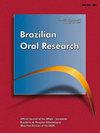Glycogen synthase kinase 3 inhibition enhances mineral nodule formation by cementoblasts in vitro
IF 2.5
4区 医学
Q2 Dentistry
引用次数: 0
Abstract
This study aimed to investigate whether GSK-3 inhibition (CHIR99021) effectively promoted mineralization by cementoblasts (OCCM-30). OCCM-30 cells were used and treated with different concentrations of CHIR99021 (2.5, 5, and 10 mM). Experiments included proliferation and viability, cellular metabolic activity, gene expression, and mineral nodule formation by Xylene Orange at the experimental time points. In general, CHIR99021 did not significantly affect OCCM-30 viability and cell metabolism (MTT assay) (p > 0.05), but increased OCCM-30 proliferation at 2.5 mM on days 2 and 4 (p < 0.05). Data analysis further showed that inhibition of GSK-3 resulted in increased transcript levels of Axin2 in OCCM-30 cells starting as early as 4 h, and regulated the expression of key bone markers including alkaline phosphatase (Alp), runt-related transcription factor 2 (Runx-2), osteocalcin (Ocn), and osterix (Osx). In addition, CHIR99021 led to an enhanced mineral nodule formation in vitro under both osteogenic and non-osteogenic conditions as early as 5 days after treatment. Altogether, the results of the current study suggest that inhibition of GSK-3 has the potential to promote cementoblast differentiation leading to increased mineral deposition in vitro.糖原合成酶激酶3抑制促进骨水泥母细胞形成矿物结节
本研究旨在探讨GSK-3抑制剂(CHIR99021)是否能有效促进成水泥细胞(OCCM-30)矿化。用不同浓度的CHIR99021(2.5、5和10 mM)处理OCCM-30细胞。实验包括二甲苯橙在实验时间点的增殖和活力、细胞代谢活性、基因表达和矿物质结节形成。总体而言,CHIR99021对OCCM-30细胞活力和细胞代谢(MTT法)无显著影响(p > 0.05),但在第2天和第4天增加了2.5 mM OCCM-30的增殖(p < 0.05)。数据分析进一步表明,抑制GSK-3可导致OCCM-30细胞中Axin2转录水平早在4 h就开始升高,并调节碱性磷酸酶(Alp)、矮子相关转录因子2 (Runx-2)、骨钙素(Ocn)和骨甾体(Osx)等关键骨标志物的表达。此外,CHIR99021早在治疗后5天就在体外促进了成骨和非成骨条件下的矿物结节形成。总之,目前的研究结果表明,抑制GSK-3有可能促进成水泥细胞分化,导致体外矿物质沉积增加。
本文章由计算机程序翻译,如有差异,请以英文原文为准。
求助全文
约1分钟内获得全文
求助全文
来源期刊

Brazilian Oral Research
DENTISTRY, ORAL SURGERY & MEDICINE-
CiteScore
3.70
自引率
4.00%
发文量
107
审稿时长
12 weeks
 求助内容:
求助内容: 应助结果提醒方式:
应助结果提醒方式:


